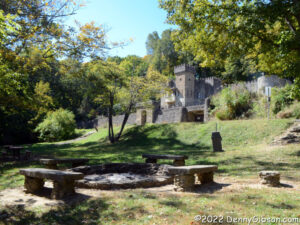 It had been several years since I last visited Chateau Laroche on the banks of the Little Miami River. I don’t know that I was ever what could be called a frequent visitor but I have been there quite a few times over the years. The first was in the mid-1970s and the last was, as I said, several years ago. Sometime last summer, when I realized just how long it had been, I decided I needed to stop by the well-known local landmark and have been waiting for an idle day with good weather. That combination finally appeared on the first Tuesday of October.
It had been several years since I last visited Chateau Laroche on the banks of the Little Miami River. I don’t know that I was ever what could be called a frequent visitor but I have been there quite a few times over the years. The first was in the mid-1970s and the last was, as I said, several years ago. Sometime last summer, when I realized just how long it had been, I decided I needed to stop by the well-known local landmark and have been waiting for an idle day with good weather. That combination finally appeared on the first Tuesday of October.
 Chateau Laroche is more commonly known as the Loveland Castle. It is almost entirely the work of Harry Andrews who was born in 1890, began construction of the castle in 1929, and continued building until his death in 1981. I don’t know exactly when Harry moved into the castle but he had been living there for a long time — sleeping beneath the dome he happily reminded visitors had been declared impossible by professional architects — when I first met him.
Chateau Laroche is more commonly known as the Loveland Castle. It is almost entirely the work of Harry Andrews who was born in 1890, began construction of the castle in 1929, and continued building until his death in 1981. I don’t know exactly when Harry moved into the castle but he had been living there for a long time — sleeping beneath the dome he happily reminded visitors had been declared impossible by professional architects — when I first met him.
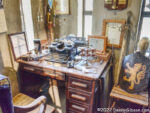
 Domed ceilings had been constructed entirely of stone hundreds of years in the past, Harry pointed out, and there was no reason they couldn’t be built today. He built this one by adding one row of stones per week. The office is where he did his writing and notarized signatures. It’s where one of my favorite Harry stories took place.
Domed ceilings had been constructed entirely of stone hundreds of years in the past, Harry pointed out, and there was no reason they couldn’t be built today. He built this one by adding one row of stones per week. The office is where he did his writing and notarized signatures. It’s where one of my favorite Harry stories took place.
I’d used Harry to notarize a couple of car titles but this time I needed my signature notarized on an affidavit for some out-of-state legal difficulties. The castle website identifies Harry as the state’s oldest notary and claims he never charged more than a quarter. I don’t want to start an argument but I’m pretty sure he was charging fifty cents at the time of this 1978 visit. Four signatures were required and I handed Harry two dollars for his services. Having read over the affidavit and realizing that some sort of fine would be involved, Harry returned a dollar explaining that it looked like I was probably going to need some extra money.

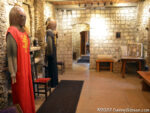
 The office and Harry’s living quarters are blocked off by gates and kept essentially as Harry left them. Much of the rest of the interior also looks pretty much the same as it did although it’s not maintained as fervidly as the personal spaces.
The office and Harry’s living quarters are blocked off by gates and kept essentially as Harry left them. Much of the rest of the interior also looks pretty much the same as it did although it’s not maintained as fervidly as the personal spaces.
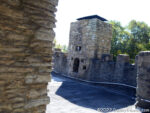
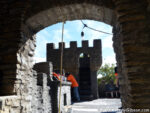 I was surprised to find a locked gate blocking access to the castle roof. The castle is owned and maintained by the all-volunteer Knights of the Golden Trail, an organization with origins in Sunday school classes Harry Andrews taught in the 1920s. There were about a hundred knights at Harry’s death. There are about three hundred today. Sir Fred and Sir Eric were working on the roof and explained that too many years of too many feet (“especially high-heeled shoes”) had created a crack and a leak that threatened the castle. They told me the crack was quite visible in the ceiling of the banquet hall (the room with the big table) and I checked it out when I went back down. Work is underway to seal the crack to head off further water damage but the roof will likely remain closed to the public permanently.
I was surprised to find a locked gate blocking access to the castle roof. The castle is owned and maintained by the all-volunteer Knights of the Golden Trail, an organization with origins in Sunday school classes Harry Andrews taught in the 1920s. There were about a hundred knights at Harry’s death. There are about three hundred today. Sir Fred and Sir Eric were working on the roof and explained that too many years of too many feet (“especially high-heeled shoes”) had created a crack and a leak that threatened the castle. They told me the crack was quite visible in the ceiling of the banquet hall (the room with the big table) and I checked it out when I went back down. Work is underway to seal the crack to head off further water damage but the roof will likely remain closed to the public permanently.
Protecting the structure is clearly of utmost importance but I was disappointed nonetheless. The rooftop deck was always a favorite spot of mine and was the scene of another Harry story. At the time, I lived just a few miles away and a neighbor’s truck-driving brother was visiting after dropping off a loaded trailer. For some reason, we decided to take his semi-tractor to the castle. For reference, it looked quite similar to this one that recently sold at auction. I rode in the middle of the cab and recall ducking reflexively as we approached low branches in the tall truck. We eventually ended up sitting on the castle rooftop chatting with Harry. The tractor could be seen from there and Harry asked just what that strange-looking vehicle was. “Why, that’s a White Freightliner”, its red-bearded owner proudly answered in his best West Virginia drawl.
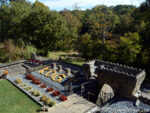
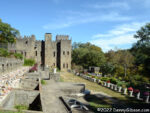
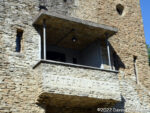 With the castle’s tallest tower inaccessible, I grabbed a picture of the Knights of the Golden Trail logo from the balcony. Then, after exploring the garden area for a bit, I got a picture of the balcony itself.
With the castle’s tallest tower inaccessible, I grabbed a picture of the Knights of the Golden Trail logo from the balcony. Then, after exploring the garden area for a bit, I got a picture of the balcony itself.
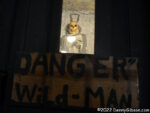
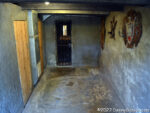 The dungeon is actually reachable from inside the castle but the curved stairway is quite low and unwanted head-banging was all too common. Today visitors are encouraged to access the locked cell and its long-suffering occupant through an exterior door.
The dungeon is actually reachable from inside the castle but the curved stairway is quite low and unwanted head-banging was all too common. Today visitors are encouraged to access the locked cell and its long-suffering occupant through an exterior door.
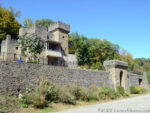 Steps leading from the castle to the road in front of it are currently closed so I walked up the road to take this picture. The archway marks the closed steps. The wide doorway beyond the steps is the garage. There can’t be very many castles around that were originally built with a garage. On the way back to the parking lot (nicely paved, BTW) I slipped down by the river to get the opening photo. Another memory l have is of canoeing past the castle and seeing it through the trees from a similar angle.
Steps leading from the castle to the road in front of it are currently closed so I walked up the road to take this picture. The archway marks the closed steps. The wide doorway beyond the steps is the garage. There can’t be very many castles around that were originally built with a garage. On the way back to the parking lot (nicely paved, BTW) I slipped down by the river to get the opening photo. Another memory l have is of canoeing past the castle and seeing it through the trees from a similar angle.
I was pleasantly surprised at the number of people touring the castle with me. At one point, I estimate there were as many as fifty curious folks exploring the building and grounds. Many were young homeschooled students from nearby. Apparently, even though the actual schooling takes place in small family units, much of it is somehow coordinated and medieval history is a common subject this time of year. Their parents were there, of course, and there were also several youngish couples without children including one I spoke with from Indianapolis. All seemed suitably impressed. The KOGT have done a fine job of taking care of Harry’s house and keeping it available to be appreciated by others.

Pingback: Book Review Southern Ohio Legends & Lore James A. Willis | Denny G's Road Trips Blog